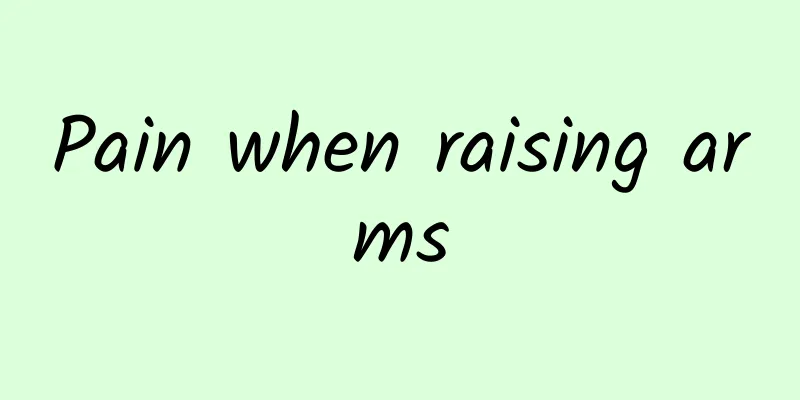Pain when raising arms

|
There are many reasons that cause pain when raising your arms, the most common of which are cold, trauma, excessive fatigue and other factors. However, these reasons are easy to rule out. If you can't find the cause and it happens frequently, you should be careful that you may have frozen shoulder. It is best for us to have a full understanding of the symptoms of frozen shoulder and make a comprehensive judgment based on our own situation before we can draw a conclusion. Clinical manifestations of frozen shoulder 1. Shoulder pain At first, the shoulder pain is paroxysmal, most of which are chronic. Later, the pain gradually intensifies or becomes dull, or knife-like, and is continuous. Climate change or fatigue often aggravates the pain. The pain can spread to the neck and upper limbs (especially the elbows). When the shoulder is accidentally collided or pulled, it often causes tearing pain. Shoulder pain is lighter during the day and heavier at night, which is a major feature of this disease. If the pain is caused by cold, the patient will be particularly sensitive to climate change. 2. Limited shoulder joint movement The movement of the shoulder joint in all directions may be restricted, and it is more obvious in abduction, elevation, internal rotation and external rotation. As the disease progresses, long-term disuse causes adhesion of the joint capsule and soft tissues around the shoulder, and the muscle strength gradually decreases. In addition, the coracohumeral ligament is fixed in a shortened internal rotation position, which restricts the active and passive movement of the shoulder joint in all directions. Actions such as combing the hair, dressing, washing the face, and putting hands on the waist are difficult to complete. In severe cases, the function of the elbow joint may also be affected. When the elbow is flexed, the hand cannot touch the shoulder on the same side, especially when the arm is extended backward, the elbow flexion cannot be completed. 3. Fear of cold Patients are afraid of cold shoulders, and many of them wrap their shoulders with cotton pads all year round. Even in summer, they dare not let the wind blow on their shoulders. 4. Tenderness Most patients can feel obvious tenderness points around the shoulder joint, which are mostly located in the tendon groove of the long head of the biceps brachii, the subacromial bursa, the coracoid process, the attachment point of the supraspinatus muscle, etc. 5. Muscle spasms and atrophy In the early stage, the deltoid muscle, supraspinatus muscle and other muscles around the shoulder may experience spasm, and in the late stage, disuse muscle atrophy may occur, with typical symptoms such as acromion protrusion, difficulty in lifting, and inability to extend backward. At this time, the pain symptoms are actually alleviated. treat Currently, the main treatment for frozen shoulder is conservative. Comprehensive therapies including oral anti-inflammatory and analgesic drugs, physical therapy, local blockade of pain points, massage, self-massage, etc. At the same time, joint function exercises are performed, including active and passive abduction, rotation, flexion, extension and rotation. When shoulder pain is significantly relieved but the joint is still stiff, manual release can be performed under general anesthesia to restore the range of joint motion. The steps and methods of self-massage are: 1. Use the thumb or palm of the healthy side to massage the front and outer side of the affected shoulder joint from top to bottom for 1 to 2 minutes. You can press the local painful point with your thumb for a while. 2. Use the pads of the 2nd to 4th fingers of the healthy hand to massage various parts of the back of the shoulder joint for 1 to 2 minutes. If you find any local pain points during the massage, you can also press them for a while with your fingers. 3. Use the healthy thumb and other fingers to knead the upper arm muscles of the affected upper limb from bottom to top to the shoulder for 1 to 2 minutes. 4. You can also use the above method to massage when the affected shoulder is in functional positions such as abduction, while moving the shoulder joint in all directions. 5. Finally, use your palms to rub from top to bottom for 1 to 2 minutes. For areas on the back of the shoulder that cannot be massaged, you can use patting method for treatment. Self-massage can be performed once a day for 1 to 2 months, which will have better effects. |
>>: The process of extracting a rotten tooth
Recommend
Why do my feet swell and hurt?
There are many acupoints on the soles of our feet...
What are the characteristics of cerebrospinal fluid in viral encephalitis?
The characteristics of cerebrospinal fluid of vir...
Swelling of both lower limbs
Some normal people will have some edema in their ...
How much is 1 gram of antelope horn
Antelope horns are the horns of saiga antelopes, ...
There is a pimple inside the ear
Acne is a common phenomenon during adolescence, e...
What to do if the skin itches and pimples appear when scratched
If the skin is itchy and bumps appear immediately...
Is the Nephrolepis poisonous?
Nephrolepis is also called round fern, comb grass...
What can't you eat if your progesterone level is low?
If a pregnant woman has low progesterone during p...
Chinese medicine treatment for myocardial ischemia, these five methods are effective!
Traditional Chinese medicine is more effective in...
Why does the back of the head hurt?
Everyone must have experienced pain in the back o...
Original formula of Yinqiao Powder
Yinqiao Powder has many functions and effects. Yi...
Can I eat green beans during confinement?
Many people believe that green beans are rich in ...
What symptoms should be treated with cystoscopy?
The function of a cystoscope is to observe condit...
Causes of cervical blood vessel obstruction
The harm caused by cervical vascular blockage is ...
What is the cause of dandruff?
Dandruff, this word is very familiar to everyone....









